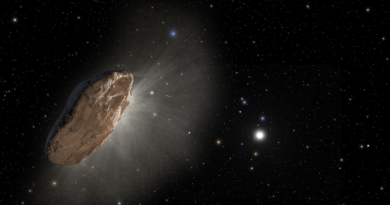Strange DNA found in the desert offers lessons in the hunt for Mars life – The Washington Post
Sign in
The Atacama Desert in Chile is just about the driest place on Earth. In spots, it looks a lot like Mars. But it’s not lifeless, even in the hyper-arid regions. Using state-of-the-art equipment to probe the desert rocks, researchers found bits of DNA from an intriguing mix of microbes.
Strikingly, 9 percent of the genetic fragments belong to organisms unknown to science, making them part of the “dark microbiome,” according to a report published Tuesday in the journal Nature Communications.
These organisms are bacteria that are “so strange and different,” as the report puts it, that researchers could not identify any known relatives.
“In almost half of the cases, the databases could not clearly say what we had in our hands,” lead researcher Armando Azua-Bustos, a microbiologist at the Center of Astrobiology in Madrid, told The Washington Post.
And that brings him back to the Mars analogy: The Atacama, he and his scientific colleagues believe, is a brilliant test bed for the search for Martian life. But the same search conducted with versions of the instruments on today’s Mars rovers could barely detect the microbial signatures. That means finding conclusive evidence of present or past life in Martian soils is going to be difficult without bringing samples back to Earth, Azua-Bustos and his colleagues concluded.
The research seems to bolster the long-term Mars exploration strategy of NASA and its partner, the European Space Agency. They are in the midst of a multistage mission called Mars Sample Return. If all goes as planned, samples of Martian soil obtained by NASA’s Perseverance rover — which just celebrated its second anniversary on Mars — will be hauled back to Earth sometime early in the next decade for scrutiny in high-containment laboratories.
But this new research also highlights the challenges facing scientists who want to know the (conjectured) biological history of Mars. Microbial life, especially if extinct and long fossilized, may exist at or beyond the farthest limit of what can be detected with the kind of instruments small enough to be blasted into space and landed on another planet.
Scientists have never found an example of life beyond Earth, but a general assumption is that “habitable” worlds will become inhabited — that life emerges, somehow, under the right conditions. The Red Planet has long tantalized astrobiologists. It was more Earthlike about 3 billion years ago, when it had a thicker atmosphere and liquid water on the surface. Conceivably, there is still cryptic life on Mars, although astrobiologists would be thrilled to find even a microfossil of something that lived billions of years ago.
NASA’s Viking mission of 1976 carried experiments designed to detect life, and one offered an initially promising signal, but most scientists concluded that they’d landed on sterile soil.
Since the Viking mission, NASA has followed a more incremental strategy focused on finding and exploring sites that show evidence of being potentially habitable billions of years ago, when Mars was warmer and wetter. Perseverance and its still active predecessor, the Curiosity rover, have found traces of organic molecules — the kind of molecules that are the basis of life as we know it — on the surface, though this is not by itself proof of a biological origin.
“The question remains whether they are meteoritic, geologic, or biologic,” said Amy Williams, a planetary scientist at the University of Florida and a member of the Curiosity and Perseverance scientific teams.
Williams said the new report from Azua-Bustos and his collaborators is important because it shows that the preservation of organic matter is limited in Mars-like environments and will be difficult to detect even with state-of-the-art laboratory instruments.
“This means that organics detection with spaceflight instruments, like on current and future Mars rovers, may be an even larger challenge, as organic matter is readily broken down in the radiation-bathed Martian surface environment,” Williams said in an email.
Still, the Atacama research shows that even a very arid environment will have layers of sedimentary rock with significant amounts of biological remnants, said Chris House, a Pennsylvania State University geologist and astrobiologist. “It is not really a surprise, but the results might have just shown uniform bleakness,” he said. That’s good news for scientists hoping dry Mars rocks might yield traces of alien biology.
Azua-Bustos is a native of the Atacama who spent years as a winemaker before becoming a scientist. He recalls growing up in a Chilean town where rain would fall only about once a year, always a highlight. There are places, he said, where residents have never seen rain going back multiple generations.
He said he would regularly pass through a region of the desert, called Red Stone, en route to a research site, and one day he decided it would be worth a closer look. The rocks were rust-red because of the presence of a mineral, hematite, that also accounts for the red color of Mars, he said.
More than 100 million years ago, in the age of dinosaurs, the Red Stone site was a river delta, much like the plateau on Mars within Jezero Crater that Perseverance is exploring.
Azua-Bustos was surprised by the genetic material of an unfamiliar nature seen in the Atacama research. All life on Earth comes from a common ancestor — so far as we know. There has been speculation, notably from scientist and author Paul Davies, that life could have originated on Earth more than once and to this day there could be a “shadow” biosphere that is simply too weird to fit into our definition of Earth life.
Azua-Bustos, however, defaults to the less spectacular interpretation of the unclassified organisms: This is relic genetic material from life forms long extinct and not previously documented.
The Perseverance rover continues to explore Jezero Crater, digging up and storing samples of Martian soil. The plan is to put another spacecraft on the surface, which would double as a launchpad. Perseverance would then deliver the samples to the lander, which would hurtle the material into orbit. There it would rendezvous with yet another vehicle, a European-built orbiter, that could transport the precious cargo back to Earth for analysis with the best possible lab instruments.
The new research suggests this may be the most effective — and possibly the only conclusive — way to find out if anything was ever alive on Mars.
“We know there are things to detect,” Azua-Bustos said. “But if your instrument is not designed to be able to detect those things, then we have a problem.”


